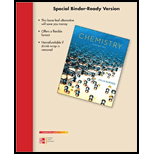
Concept explainers
Carry out the following conversions: (a)
Interpretation:
The given conversions are to be carried out by dimensional analysis.
Concept introduction:
Dimensional analysis is a way to convert the units of measurement. In order to convert one unit to another, one needs to know the relationship between those units. These relationships are called conversion factors. Dimensional analysis is used to set up and solve a unit conversion problem using conversion factors.
Conversion factor is a fraction obtained from a relationship between the units. It is written as a ratio, and can be inverted to give two conversion factors for every relationship.
Answer to Problem 55QP
Solution:
a)
b)
c)
d)
Explanation of Solution
a)
Convert the quantity
The conversion factors for the relationship
The conversion factors for the relationship
Now, set up the unit conversion problem using the appropriate conversion factors.
The units in the conversion factor must cancel to give the correct unit for the answer. The answer is rounded off to
Hence,
b)
Convert the quantity
The conversion factors for the relationship
Now, set up the unit conversion problem using the appropriate conversion factor.
The units in the conversion factor must cancel to give the correct unit for the answer.
Hence,
c)
Convert the quantity
The conversion factors for the relationship
Now, set up the unit conversion problem using the appropriate conversion factor.
The units in the conversion factor must cancel to give the correct unit for the answer. The answer is rounded off to
Hence,
d)
Convert the quantity
The conversion factors for the relationship
The conversion factors for the relationship
Now, set up the unit conversion problem using the appropriate conversion factors.
The units in the conversion factor must cancel to give the correct unit for the answer.
Hence,
Want to see more full solutions like this?
Chapter 1 Solutions
Chemistry - With Access (Looseleaf) (Custom)
- A typical laboratory beaker has a volume of 250. mL What is its volume in cubic centimeters? In liters? In cubic meters?In cubic decimeters?arrow_forwardGold leaf, which is used for many decorative purposes, is made by hammering pure gold into very thin sheets. Assuming that a sheet of gold leaf is 1.27 105 cm thick, how many square feet of gold leaf could be obtained from 28.35 g gold? The density of gold is 19.3 g/cm3.arrow_forwardThe density of a solution of sulfuric acid is 1.285 g/cm3, and it is 38.08% acid by mass. Calculate the volume of the acid solution (in mL) you need to supply 125 g of sulfuric acid.arrow_forward
- One year of world production of gold was 49.6 106 troy ounces. One troy ounce equals 31.10 g. What was the world production of gold in metric tons (106 g) for that year?arrow_forwardWhat is the volume of liquid in the buret in the illustration? Note that the volumes on a buret, expressed in milliliters, are sequenced in the opposite direction of a graduated cylinder.arrow_forwardEthylene glycol, C2H6O2, is an ingredient of automobile antifreeze. Its density is 1.11 g/cm3 at 20 C. If you need 500. mL of this liquid, what mass of the compound, in grams, is required?arrow_forward
- The radius of an atom is on the order of1010 m. What is this radius in centimeters? In inches? In nanometers?arrow_forwardIf a troy pound equals 12 troy ounces, and a troy ounce equals 31.1 grams, what is the mass in grams of a 3 troy pounds of silver?arrow_forwardThe drug cyclophosphamide is administered for breast cancer at a daily dose of 100 mg/m^2 for up to 14 consecutive days. The BSA of a patient measuring 5 ft and 1 inch in height and weighing 95 lbs is ____ m^2, and total quantity administered over the 2-week period is ____ g.arrow_forward
- The density of mercury, the only metal to exist as a liquid at room temperature, is 104g/cm^3. What is that density in pounds per cubic inch, lb/in^3?arrow_forwardWhat is the density of lithium metal in g/cm3, if a cube measuring 0.82 cm x 1.45 cm x 1.25 cm has a mass of 0.794 g?arrow_forwardWhat is the volume in cm3 of 1.8 cubic feet?arrow_forward
 Chemistry: The Molecular ScienceChemistryISBN:9781285199047Author:John W. Moore, Conrad L. StanitskiPublisher:Cengage Learning
Chemistry: The Molecular ScienceChemistryISBN:9781285199047Author:John W. Moore, Conrad L. StanitskiPublisher:Cengage Learning Chemistry & Chemical ReactivityChemistryISBN:9781337399074Author:John C. Kotz, Paul M. Treichel, John Townsend, David TreichelPublisher:Cengage Learning
Chemistry & Chemical ReactivityChemistryISBN:9781337399074Author:John C. Kotz, Paul M. Treichel, John Townsend, David TreichelPublisher:Cengage Learning Introductory Chemistry: A FoundationChemistryISBN:9781337399425Author:Steven S. Zumdahl, Donald J. DeCostePublisher:Cengage Learning
Introductory Chemistry: A FoundationChemistryISBN:9781337399425Author:Steven S. Zumdahl, Donald J. DeCostePublisher:Cengage Learning General Chemistry - Standalone book (MindTap Cour...ChemistryISBN:9781305580343Author:Steven D. Gammon, Ebbing, Darrell Ebbing, Steven D., Darrell; Gammon, Darrell Ebbing; Steven D. Gammon, Darrell D.; Gammon, Ebbing; Steven D. Gammon; DarrellPublisher:Cengage Learning
General Chemistry - Standalone book (MindTap Cour...ChemistryISBN:9781305580343Author:Steven D. Gammon, Ebbing, Darrell Ebbing, Steven D., Darrell; Gammon, Darrell Ebbing; Steven D. Gammon, Darrell D.; Gammon, Ebbing; Steven D. Gammon; DarrellPublisher:Cengage Learning Chemistry & Chemical ReactivityChemistryISBN:9781133949640Author:John C. Kotz, Paul M. Treichel, John Townsend, David TreichelPublisher:Cengage Learning
Chemistry & Chemical ReactivityChemistryISBN:9781133949640Author:John C. Kotz, Paul M. Treichel, John Townsend, David TreichelPublisher:Cengage Learning Introductory Chemistry: An Active Learning Approa...ChemistryISBN:9781305079250Author:Mark S. Cracolice, Ed PetersPublisher:Cengage Learning
Introductory Chemistry: An Active Learning Approa...ChemistryISBN:9781305079250Author:Mark S. Cracolice, Ed PetersPublisher:Cengage Learning





